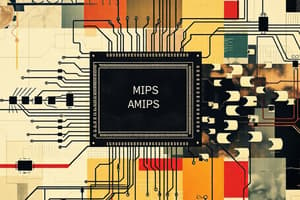Podcast
Questions and Answers
What is the last topic included in the syllabus for the class test?
What is the last topic included in the syllabus for the class test?
- Control constructs
- While loop
- Do while loop
- For loop (correct)
Which of the following topics is NOT mentioned in the syllabus for the class test?
Which of the following topics is NOT mentioned in the syllabus for the class test?
- Number system
- Complex data structures (correct)
- Control constructs
- C-tokens
Which of the following is a topic included in the syllabus?
Which of the following is a topic included in the syllabus?
- Advanced algorithms
- Networking fundamentals
- Functions in C
- Introduction to C-tokens (correct)
What kind of constructs are included in the syllabus?
What kind of constructs are included in the syllabus?
Which of the following data types is explicitly part of the syllabus?
Which of the following data types is explicitly part of the syllabus?
Which operator type is specifically used to return one value if a condition is true and another if false?
Which operator type is specifically used to return one value if a condition is true and another if false?
What is the primary purpose of bitwise operators in programming?
What is the primary purpose of bitwise operators in programming?
Which of the following correctly describes increment and decrement operators?
Which of the following correctly describes increment and decrement operators?
What type of operators are used for performing logical operations on two variables?
What type of operators are used for performing logical operations on two variables?
In which order do operators operate when there are multiple types present in a single expression?
In which order do operators operate when there are multiple types present in a single expression?
Which operator is used to compare two values for equality?
Which operator is used to compare two values for equality?
What is the result of the expression A % B when A is 10 and B is 20?
What is the result of the expression A % B when A is 10 and B is 20?
How is a bitwise AND assignment operator represented?
How is a bitwise AND assignment operator represented?
What does the expression C += A accomplish?
What does the expression C += A accomplish?
What is the precedence of the multiplication (*) operator compared to the addition (+) operator?
What is the precedence of the multiplication (*) operator compared to the addition (+) operator?
When using the decrement operator (--) on a variable X, what is the resulting value?
When using the decrement operator (--) on a variable X, what is the resulting value?
Which of the following operators checks if the left operand is greater than the right operand?
Which of the following operators checks if the left operand is greater than the right operand?
In the expression v ^= exp, what does '^=' signify?
In the expression v ^= exp, what does '^=' signify?
What will the expression (A < B) && (A > 10) evaluate if A is 5 and B is 10?
What will the expression (A < B) && (A > 10) evaluate if A is 5 and B is 10?
What will the logical OR operator (||) return if both operands are zero?
What will the logical OR operator (||) return if both operands are zero?
Which operator would reverse the logical state of true to false?
Which operator would reverse the logical state of true to false?
What is the result of the expression (A & B) when A is 60 and B is 13?
What is the result of the expression (A & B) when A is 60 and B is 13?
What will the expression (A | B) evaluate to if A is 60 and B is 13?
What will the expression (A | B) evaluate to if A is 60 and B is 13?
How does the bitwise NOT operator (~) affect the value of A, if A is 60?
How does the bitwise NOT operator (~) affect the value of A, if A is 60?
If N is 5, what will the expression ~N evaluate to?
If N is 5, what will the expression ~N evaluate to?
What is the result of A++ when A is 7?
What is the result of A++ when A is 7?
Flashcards are hidden until you start studying
Study Notes
Class Test Syllabus Overview
- Syllabus covers topics from the start of the course up to the "for" loop.
- Understanding of fundamental computing concepts is crucial.
Topics Included in the Syllabus
- Introduction to Computer System: Basics of computer architecture and function.
- Number System: Comprehension of different numerical representations (binary, decimal, hexadecimal).
- Flow Chart and Algorithm: Techniques for problem-solving and process visualization.
- Introduction to C Tokens: Basic components in the C programming language.
- Keywords and Identifiers: Specific reserved words in C and how to name variables meaningfully.
- Data Types: Different types of data (int, char, float) and their usage.
- Variables: Concepts of storage and manipulation of data within a program.
- Operators: Understanding arithmetic, relational, and logical operators in C.
- Control Constructs: Overview of loop constructs:
- While Loop: Executes as long as a condition is true.
- Do While Loop: Executes at least once before checking a condition.
- For Loop: A control structure for executing a block of code a specified number of times.
Operators in Programming
- Operators manipulate values or variables, instructing the compiler to perform mathematical or logical operations.
- Categories of operators include Unary (one operand), Binary (two operands), and Ternary (three operands).
Types of Operators
- Arithmetic Operators: Perform calculations like addition (+), subtraction (-), multiplication (*), division (/), and modulus (%).
- Relational Operators: Compare values of two variables with operators such as
==,!=,>,<,>=,<=. - Logical Operators: Combine boolean expressions; include AND (&&), OR (||), and NOT (!).
- Bitwise Operators: Perform operations on binary representations of integers, including AND (&), OR (|), NOT (~), and XOR (^).
- Assignment Operators: Assign values to variables; simple (
=) and compound (+=,-=). - Conditional Operators: A ternary operator that evaluates a condition and returns one of two values based on the Boolean outcome.
- Increment/Decrement Operators: Unary operators to increase (
++) or decrease (--) the value of a variable.
Logical Operators
- AND (&&): True if both operands are non-zero; for example,
(A > 10) && (B > 15)yields 0 if either condition is false. - OR (||): True if at least one operand is non-zero; for example,
(A > 10) || (B > 15)yields 1 if either condition is true. - NOT (!): Reverses the logical state; for example,
!(A > 10)yields 1 if the condition is false.
Bitwise Operators
- AND (&): Results in a bit being set if it's set in both operands; e.g.,
(A & B)equals 12. - OR (|): Results in a bit being set if it's set in either operand; e.g.,
(A | B)equals 61. - NOT (~): Flips the bits of the operand; e.g.,
(~A)results in -61. - XOR (^): Results in a bit being set if it's set in one operand but not both; e.g.,
(A ^ B)equals 49. - Right Shift (>>): Moves left operand bits to the right by specified bits; e.g.,
A >> 2results in 15.
Arithmetic Operators
- Addition (+): Combines two operands; e.g.,
A + Bequals 30. - Subtraction (-): Deducts the second operand from the first; e.g.,
A - Bequals -10. - Multiplication (*): Produces the product of both operands; e.g.,
A * Bequals 200. - Division (/): Divides numerator by denominator; e.g.,
B / Aequals 2, depending on operand types. - Modulus (%): Produces the remainder of division; e.g.,
A % Bequals 10.
Assignment Operators
- Simple assignment (
=): Assigns values from the right operand to the left; e.g.,C = A + B. - Compound assignment: Combines assignment with arithmetic operations; e.g.,
C += Ais equivalent toC = C + A. - Bitwise assignment: Combines bitwise AND, OR, etc., with assignment; e.g.,
C &= 2is equivalent toC = C & 2.
Relational Operators
- Equality (==): Checks if two operands are equal; yields 0 for false.
- Inequality (!=): Checks if two operands are not equal; yields 1 for true.
- Greater than (>): Checks if the left operand is greater than the right; yields 0 for false.
- Less than (<): Opposite of greater than; conditions similar in result.
- Greater than or equal to (>=) and Less than or equal to (<=): Combine both conditions of equality and comparison.
Studying That Suits You
Use AI to generate personalized quizzes and flashcards to suit your learning preferences.




